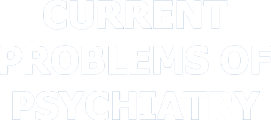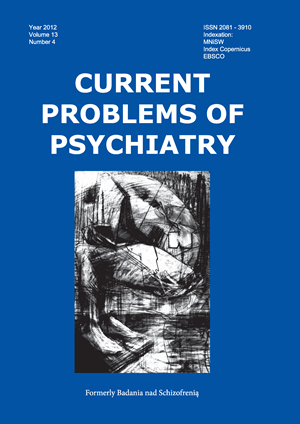Występowanie depresji poporodowej w grupie kobiet w połogu a sytuacja socjodemograficzna i relacje rodzinne
DOI:
https://doi.org/10.12923/j.2081-3910/13.4/a.04Słowa kluczowe:
depresja poporodowa, połóg, relacje rodzinne, Edynburska Skala Depresji PoporodowejAbstrakt
Wstęp. Ciąża i połóg są okresami, w których dochodzi do wahania nastroju i zmian hormonalnych w organizmie kobiety. Pojawienie się zaburzeń depresyjnych podczas połogu jest około dziesięciokrotnie częstsze niż w innym czasie.
Cel. Celem pracy była analiza występowania depresji poporodowej w grupie kobiet w połogu zależnie od sytuacji socjodemograficznej i relacji rodzinnych.
Materiał i metoda. Badania przeprowadzono wśród 130 położnic, pomiędzy czwartym a dwunastym tygodniem połogu. Zastosowane narzędzie badawcze stanowił autorski kwestionariusz ankiety oraz Edynburska Skala Depresji Poporodowej (ESDP, ang. Edinburgh Postnatal Depression Scale).
Wyniki. Na podstawie przeprowadzonych badań stwierdzono objawy depresji poporodowej u 40,00% ankietowanych, zaś 60,00% badanych kobiet nie miało objawów depresji poporodowej. Ponadto stwierdzono istotny związek pomiędzy występowaniem depresji poporodowej a wiekiem, (p=0,03) i stanem cywilnym (p=0,0006). Wykazano również istotny statystycznie związek pomiędzy występowaniem objawów depresji a oceną relacji z partnerem, (p=0,00001), z własnymi rodzicami(p=0,0006) oraz teściami (p=0,008).
Wnioski. Wiek, stan cywilny oraz relacje rodzinne mają istotny wpływ na występowanie objawów depresji w okresie połogu. Szczególnej uwagi wymagają położnice poniżej 25 roku życia, stanu wolnego oraz te, które mają złe relacje z mężem/partnerem, własnymi rodzicami oraz teściami. Kobiety, u których stwierdzono poziom depresji ≥ 12 punktów powinny być objęte opieką psychologa lub psychiatry celem potwierdzenia, bądź wykluczenia depresji poporodowej. Położne i pielęgniarki rodzinne powinny stosować narzędzia skriningowe w praktyce zawodowej celem identyfikacji pacjentek z zaburzeniami depresyjnymi w okresie połogu.
Bibliografia
1. Robertson E., Celasun N., Steward D.E. Risk factors for postpartum depression. W: Steward D.E., Robertson E., Dennis C., Grace S., Wallington T. red., Postpartum depression: literature review of risk factors and interventions. Toronto; Public Health: 2003: 9-71.
2. Nylen K., Moran T., Franklin C., O’Hara M. Maternal depression: A review of relevant treatment approaches for mothers and infants. Inf. Ment. Health J. 2006; 27: 327–343. https://doi.org/10.1002/imhj.20095
3. Kaźmierczak M., Gebuza G., Gierszewska M. Zaburzenia emocjonalne okresu poporodowego. Probl Pielęg 2010; 18, 4: 503-5011.
4. Sharma V., Sharma P. Postpartum depression: diagnostic and treatment issues. J Obstet Gynaecol Can 2012; 43, 5: 436-442.
5. Rymaszewska J., Dolna M., Grzyboś M., Kiejna A. Zaburzenia psychiczne okołoporodowe- epidemiologia, etiologia, klasyfikacja, leczenie. Ginekol Pol 2005, 4, 76; 322- 330.
6. Heitzman J., Wojnar N. Zaburzenia i choroby afektywne. W: Heitzman J. red., Psychiatria. Podręcznik dla studiów medycznych. Warszawa; Wyd. Lek PZWL: 2007, 118-119, 128-130.
7. Cox J.L., Holden J.M., Sagovsky R. Detection of postnatal depression: development of the 10-item Edinburgh Postnatal Depression Scale. Br J Psychiatry. 1987; 150: 782-786. https://doi.org/10.1192/bjp.150.6.782
8. Makara-Studzińska M., Iwanowicz-Palus G. Edynburska Skala Depresji Poporodowej. W: Makara- Studzińska M., Iwanowicz-Palus G. red., Psychologia w położnictwie i ginekologii. Warszawa; Wyd. Lek PZWL: 2009; 222-224.
9. Podolska M.Z., Majkowicz M., Sipak-Szmigiel O., Ronin-Walkowska E. Kohabilitacja jako silny czynnik predykcyjny depresji okołoporodowej. Ginekol Pol 2009; 4: 280-284.
10. Makara-Studzińska M. Zaburzenia psychiczne u kobiet w okresie okołoporodowym. W: Makara- Studzińska M., Iwanowicz-Palus G. red., Psychologia w położnictwie i ginekologii. Warszawa; Wyd. Lek PZWL: 2009; 206-211.
11. Jaeschke R., Siwek M., Dudek D. Poporodowe zaburzenia nastroju – update 2012. Neuropsychiatr i Neuropsychol 2012; 7, 3: 113-121.
12. Sharma V., Khan M. Identification of bipolar disorder in women with postpartum depression. Bipolar Disord 2010; 12: 335-340. https://doi.org/10.1111/j.1399-5618.2010.00809.x
13. Reroń A., Gierat B., Huras H. Ocena częstotliwości występowania depresji poporodowej. Ginekol Prakt 2004, 3; 32-35.
14. Rich-Edwards J., Kleinman K., Abrams A. i wsp. Sociodemographic predictowrs of antenatal and postpartum depressive symptoms among women in a medical group practice. J Epidemiol Community Health 2006; 60: 221-227. https://doi.org/10.1136/jech.2005.039370
15. Silva R., Jansen K., Souza L. i wsp. Sociodemographic risk factors of perinatal depression: a cohort study in the public health care system. Rev Bras Psiquiatr 2012; 34: 143-148. https://doi.org/10.1590/s1516-44462012000200005
16. Wiktor H., Humeniuk E., Lewicka M., Kanadys K., Wnuczek I. Defining the Risk of Postpartum Depression Occurrence After Childbirth. W: Kaczor A, Borzęcki A, Iskra M. red., Środowiskowe źródła zagrożeń zdrowotnych. Lublin; 2007, Tom 1, 380-384.
17. Chandran M., Tharyan P., Muliyil J., Abraham S. Post-partum depression in a cohort of women from a rural area of Tamil Nadu India: incidence and risk factors. BJP 2002; 181: 499-504. https://doi.org/10.1192/bjp.181.6.499
18. Lewicka M., Humeniuk E., Wiktor H., Wdowiak A., Wiktor K. Family Conditions and the Degree of Postpartum Depression in Women After Childbirth. Kaczor A, Borzęcki A, Iskra M. red., Środowiskowe źródła zagrożeń zdrowotnych. Lublin; 2007, Tom 1, 342-345.
19. Bilszta J., Tang M., Meyer D., Milgrom J., Ericksen J., Buist A. Single motherhood versus poor partner relationship: outcomes for antenatal mental health. Australian and New Zealand Journal of Psychiatry 2008; 42, 1: 56-65. https://doi.org/10.1080/00048670701732731
20. Chrzan-Dętkoś M., Dyduch-Maroszek A., Humięcka A., Karasiewicz K. Uwarunkowania i konsekwencje depresji poporodowej. Psychoterapia 2012; 2, 161: 55-63.
Pobrania
Opublikowane
Numer
Dział
Licencja
Prawa autorskie (c) 2012 Autorzy

Praca jest udostępniana na licencji Creative Commons Attribution-NonCommercial-NoDerivatives 3.0 Unported License.


